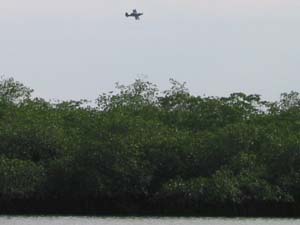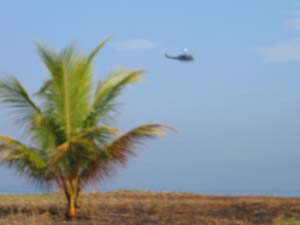« The end of the FARC's "retreat"? | Main | The 2006 aid request (2): the rest of the world, and the decline of the drug war »
February 15, 2005
Cali's El País on fumigation contractors in Tumaco
Cali’s newspaper, El País, ran an interesting article on Sunday about the U.S. personnel, mostly private contractors, who fumigate coca in Tumaco, a port city on the Pacific coast in Nariño department, not far from Ecuador.
While the approximately 20 U.S. advisors for Plan Colombia – military and civilian – do not have much contact with the population of the “Pearl of the Pacific” [as Tumaco is sometimes called], so little contact that some in fact do not notice their presence, the Tumaqeños look poorly on the fact that foreign citizens are tied to activities that they consider an act of aggression.
I saw these fellow U.S. citizens when paying a visit to Tumaco last April. Actually, anyone who flies into Tumaco sees them because they’re right there at the airport.
I’ve been to other civilian airports in Colombia that have a police base attached with contract personnel doing the fumigation, such as San José del Guaviare or Villagarzón, Putumayo. But much tighter security at those facilities made it much harder to see the spray planes and contractors, who were confined to a separate area. Not so in Tumaco’s airport, they are they right there, mixed in with the traveling public.
 |
 |
 |
When getting off one’s plane on the tarmac, there they are. Walking the 50 yards or so to the terminal, you go between ranks of brand-new-looking spray aircraft. Once in the terminal, only a chain-link fence separates the often crowded, not-very-secure waiting area from the contractors’ planes and facilities only yards away. (Despite being very much out in the open, they and the Colombian police gave a hard time to a Colombian colleague who was documenting our trip on video and couldn’t resist taking footage of the planes from our table in the airport cafeteria.)
The contractors themselves are hard to miss as the regular flights to and from Cali come and go. Some are hanging out by their facility. Some are sitting around in the cafeteria, brushing off attempts to start a conversation. They seemed pretty bored in between missions; while waiting for our bags, in fact, we saw one of these goodwill ambassadors happily jogging down the runway, waving around one of those blow-up dolls they sell in adult shops while his buddies laughed.
Though it pays well – usually over $100,000 per year – theirs is a very strange life. Their stay in Tumaco only lasts a few weeks or months, then they go home for a while only to come back again. While there, they see little of the town or its people, limited to shuttling back and forth from the airport to their hotel (where we also found ourselves staying), and perhaps to the nearby naval base, in SUVs and buses with tinted windows and no license plates.
If they ventured out, they would see a city of 100,000-plus people that is an utter basket case. Poverty for much of the city’s Afro-Colombian majority is extreme, with squalid conditions, at times recalling Port-au-Prince, making Bogotá slums like Ciudad Bolívar look prosperous by comparison. The municipal government is broke and will be for years due to astronomical debts brought on by rampant corruption and mismanagement. Between 2001 and 2004, incredibly, the town went through 62 mayors.
The port city is part of a much larger county by the same name; the vast rural zone, with rivers flowing from jungle to the ocean, is full of mangrove swamps, generations-old afro-Colombian communities, fishing villages, and – in a development that didn’t exist even 7 or 8 years ago – coca fields. The rural zone is violent, with FARC guerrillas and paramilitaries constantly jockeying for control over coca money and trafficking routes. (On top of everything else, Tumaco is one of Colombia’s main export points for illegal drugs.)
In mid-2001, a major military offensive, “Operation Tsunami,” temporarily reduced the guerrilla presence in the area. In the operation’s aftermath, the guerrillas returned to rural Tumaco, and paramilitary groups – which had barely established themselves beforehand – greatly increased their presence in the urban center and control of neighborhoods. In 2001 and 2002 they carried out a wave of selective killings (including that of an activist nun, Yolanda Cerón) and “social cleansing” murders of prostitutes, street children and other “undesirables,” while extorting local businesspeople and hooking into local government.
The chief of the AUC’s local “Liberators of the South” bloc, Guillermo Pérez Alzate or “Pablo Sevillano,” is wanted in connection with a shipment of 11 tons of cocaine, and is believed to have coordinated the North Valle Cartel's “mule” operation (recruiting women to board planes to the United States after swallowing sealed packets of drugs). A recent convert to paramilitarism, he paid large sums to the AUC sometime after 2001 for control of southern Pacific coast narcotrafficking routes and for permission to wear the AUC label. According to Moritz Ackerman, a columnist for the Medellín daily El Colombiano, Perez's group routinely does business with guerrillas: “in the department of Nariño, in a region called ‘Coca City,’ the ‘Liberators of the South’ paramilitaries buy the harvest and the FARC's 29th Front supervises the refining of cocaine.”
I have no idea whether the U.S. citizens running the spray program in Tumaco, who hardly stray from the airport, the navy base and their hotel, know or care about any of this. But if you’re in Tumaco, it’s hard to miss them doing their job. Early in the morning, every morning I was there, you hear the “Apocalypse Now” sound of the spray planes’ police escort helicopters taking off. Shortly afterward, the U.S.-provided, U.S. citizen-piloted spray planes fly out, on their way to spray more herbicides over one of Colombia’s poorest, most neglected regions.
Posted by isacson at February 15, 2005 08:58 AM
Trackback Pings
TrackBack URL for this entry:
http://ciponline.org/cgi-bin/mt-tb.cgi/56
Comments
Post a comment
Thanks for signing in, . Now you can comment. (sign out)
(If you haven't left a comment here before, you may need to be approved by the site owner before your comment will appear. Until then, it won't appear on the entry. Thanks for waiting.)